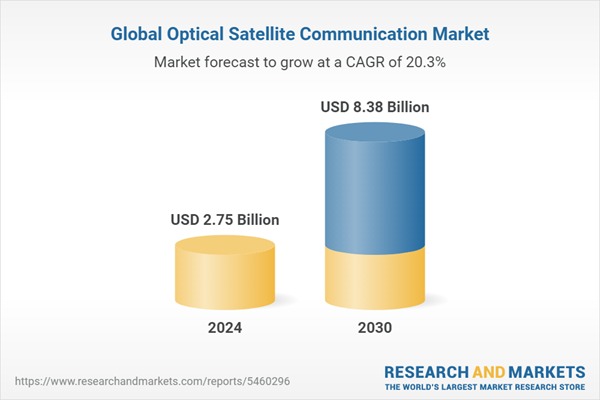Global Optical Satellite Communication Market by Component (Demodulator, Laser, Modulator), Type (Satellite-to-Ground Communication, Satellite-to-Satellite Communication), Application, End-User - Forecast 2024-2030
Dublin, Ireland. March 21, 2024 - The Optical Satellite Communication Market size was estimated at US$ 2.30 billion in 2023, USD 2.75 billion in 2024, and is expected to grow at a CAGR of 20.27% to reach USD 8.38 billion by 2030 according to Research and Markets.
 |
Optical satellite communication is an innovative form of telecommunication that employs optical signal technology to send and receive data between satellites, airborne platforms, and ground stations. This state-of-the-art mechanism utilizes the open space as a medium for data transmission, thereby eradicating the requirement for a physical medium such as fiber and copper. Rising multimedia services across the world and increasing demand for real-time communication are driving significant optical satellite communication growth. However, limited performance in atmospheric turbulence and extensive deployment cost of optical satellite communication hinder market growth. However, several market players are working on these issues to overcome and offer significant scope for business development and expansion in the optical satellite communication market. Furthermore, the integration of ultra-short pulses with the help of advanced modulation and increasing investment by private players in optical satellite communication have been recognized as potential opportunities for market expansion.
Regional Insights
In the Americas region, the growth of optical satellite communication is driven by the constant demand for advanced communication technologies for data centers, enterprises, and cloud services. The region is characterized by the presence of the largest technology players, suggesting a potential surge in adoption in the coming years. Furthermore, government initiatives to improve telecommunication infrastructure and services, alongside increased focus on space exploration, have significantly fueled the growth of the optical satellite communication market. The rapid digital transformation across various industries in Europe is escalating the demand for high-speed communication networks that optical satellite communication provides. The deployments are particularly high in countries such as the UK and Germany, owing to the presence of several communication and aerospace companies. Coupled with liberal government policies and investment in research and development, Europe holds a significant role in shaping the future of optical satellite communication. In the APAC region, rising disposable incomes have led to increased adoption of smart devices, including smartphones, creating a need for the deployment of optical satellite communication. China is focussing on developing its own global positioning system, leading to multiple satellite launches. India is rapidly advancing its space program, with the Indian Space Research Organisation (ISRO) investing heavily in optical satellite communication.
FPNV Positioning Matrix
The FPNV Positioning Matrix is pivotal in evaluating the Optical Satellite Communication Market. It offers a comprehensive assessment of vendors, examining key metrics related to Business Strategy and Product Satisfaction. This in-depth analysis empowers users to make well-informed decisions aligned with their requirements. Based on the evaluation, the vendors are then categorized into four distinct quadrants representing varying levels of success: Forefront (F), Pathfinder (P), Niche (N), or Vital (V).
Market Share Analysis
The Market Share Analysis is a comprehensive tool that provides an insightful and in-depth examination of the current state of vendors in the Optical Satellite Communication Market. By meticulously comparing and analyzing vendor contributions in terms of overall revenue, customer base, and other key metrics, we can offer companies a greater understanding of their performance and the challenges they face when competing for market share. Additionally, this analysis provides valuable insights into the competitive nature of the sector, including factors such as accumulation, fragmentation dominance, and amalgamation traits observed over the base year period studied. With this expanded level of detail, vendors can make more informed decisions and devise effective strategies to gain a competitive edge in the market.
Key Company Profiles
The report delves into recent significant developments in the Optical Satellite Communication Market, highlighting leading vendors and their innovative profiles. These include Airbus SE, Al Yah Satellite Communications Company P.J.S.C., ALCAD ELECTRONICS SL, Aperture Optical Sciences Inc., Astrogate Labs, ATLAS Space Operations, Inc., Ball Corporation, BridgeComm, Inc., Exail SAS, FSO Instruments, G&H Group, General Dynamics Mission Systems, Inc., Gomspace A/S, Hangzhou DAYTAI Network Technologies Co.,Ltd., Hangzhou Softel Optic Co., Ltd., HENSOLDT AG, Hisdesat Servicios Estrategicos S.A., Honeywell International Inc., Inmarsat Global Limited by Viasat, Inc., Intelsat, KEPLER, Kongsberg Gruppen ASA, Laser Light Communications Inc., LightPath Technologies, Inc., Maxar Technologies Inc., Mitsubishi Electric Corporation, Mynaric AG, Safran S.A., Space Micro Inc. by Voyager Space Holdings, Inc., Tesat-Spacecom GmbH & Co. KG, Thales Group, and UGrid Network Inc.
This report also includes a complimentary Excel file with data from the report for purchasers at the Site License or greater level.
For more information visit https://www.researchandmarkets.com/reports/5460296/global-optical-satellite-communication-market-by





